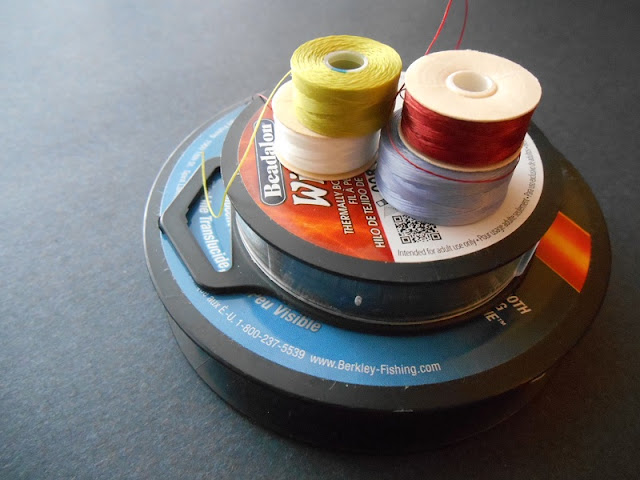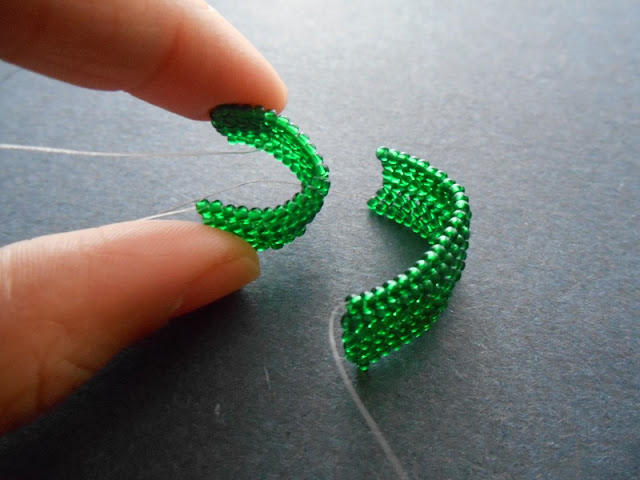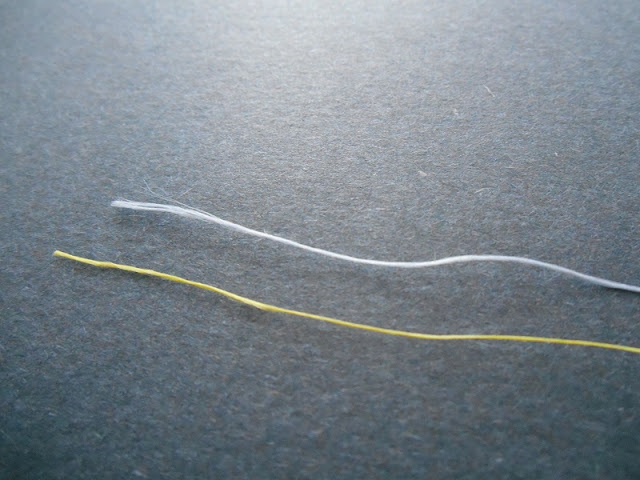Unlike the seed bead comparison that we did awhile back, I included prices in these comparisons. The price gaps between thread brands is quite a bit larger than those within bead brands, so I think it’s worth noting. To make this comparison, I looked at the single item (non-discounted) price of the largest and smallest spools available – from Fire Mountain Gems and Beads for all but WildFire – and calculated the price per yard from each spool.
This experiment isn’t exactly scientific. I did not cut a particular length of thread or set aside a particular amount of beads to work with. The overall look of the beadwork and the features of the threads themselves are the main focus. I took a bit of each thread and worked a small strip of beadwork with it. This time around I went with flat herringbone weave. I wanted a flat stitch that would showcase different qualities easily, and whose overall look wouldn’t be affected much by the beads themselves. For each swatch I used the same color – transparent emerald.
Nymo
Price: $0.03-$0.02 per yard
Colors: Black, white, brown, blue, red, yellow, green (varying shades)
Probably the most common thread used by beaders, Nymo is a nylon thread that got its start in furniture upholstery. It usually comes on smaller spools or bobbins, and is available in a variety of sizes. I worked with Size D Nymo in three colors: black, white, and shoe red.
It’s very easy to see in the photos just how much thread color affects the look of the transparent beads. Although the color of the shoe red does get masked a bit, the shade of the seed beads is definitely different compared to the beadwork done with white Nymo.
I waxed both the white and red threads, but left the black untreated (all 3 were stretched). The lack of wax didn’t change the beadwork much, but it did make the thread a little trickier to work with. Nymo is very limp and slippery, so a coating of beeswax helps to prevent the thread from slipping off the needle while working, and makes it easier to grip tail threads when starting a new piece. In theory, a bit of wax can also help prevent fraying of the beadwork over time.
This type of thread is very prone to fraying, particularly at the ends, making it a little difficult to thread a needle. Nymo is also very soft, and doesn’t change shape much. You can see that there are almost no kink marks in the working thread from where it was folded over the needle. This quality also makes for incredibly flexible beadwork – it folds over easily without breaking or becoming misshapen.
Fireline
Price: $0.23 per yard
Colors: Smoke (gray), Crystal (translucent white), green, chartreuse, red, orange, pink
Fireline is another popular beading thread that began as something different - it is also a very popular fishing line. Fireline is made from a fused nylon-Dyneema blend. It comes in very small diameters, giving it the look of thread, but is incredibly strong. I worked with 6lb test (Size D) Fireline in two colors: smoke and crystal.
Because neither of the common Fireline colors is very stark, there isn’t a lot of difference in the beadwork colors. The color of either thread is most noticeable between the beads, so it’s important to consider the type of stitch as well as bead color when choosing which type of Fireline to use.
Fireline is the thinnest of all the threads that I worked with in this experiment, so it is great for beadwork requiring lots of thread passes. It has a very plastic-y texture and kinks readily. This also means that it holds the shape of the beadwork it is used in, making it very sturdy, but also a bit inflexible. Fireline is more suitable for weaving, but doesn’t work quite as well in fringes.
Although Fireline doesn’t fray – I haven’t seen a strand actually unravel in seven years of beading – it can be tricky to cut without good tools. Dull cutting tools or a lack of tension when cutting can mangle the ends of the thread, and even cause burrs to form that are impossible to thread through a needle.
C-Lon
Price: $0.02 per yard
Colors: Black, white, brown, blue, green, red (varying shades)
Another nylon thread that is great for beadweaving, C-Lon is similar to Nymo in many ways. It comes in several sizes, including heavier weights for stringing, and is wound on a tube like cotton cord. I worked with size AA C-Lon in chartreuse, and size D in light blue.
Even though the two shades of C-Lon that I had to work with were very similar in shade and tone, you can still see a bit of an effect within the beadwork for each color. I left the size D thread unwaxed, and once again there was not much a difference apart from workability. The ends frayed a bit more with the unwaxed thread, which may have been helped along by how much bigger it is for passing through a tiny needle eye.
The C-Lon required a lot less stretching than the Nymo, which always feels a bit springy no matter how much it is stretched. Though the overall texture of the threads is almost identical, there is a noticeable difference in the sizes between these two nylon brands. Although the size D C-Lon seems enormous compared to all of the other threads, when weaving it did not seem bulky or cumbersome; it would likely be suitable for all but the most thread-heavy stitches, as well as all types of fringe.
WildFire
Price: $0.15 per yard
Colors: White, black, green
WildFire is a bonded synthetic thread similar in many ways to Fireline, and was definitely the most surprising thread in this experiment for me. As a die-hard Fireline fan, I have always been reluctant to try WildFire, particularly because it is only sold in small quantities at most stores. I used 12lb test WildFire in black.
The most noticeable thing about WildFire is the intensity of its jet black color. Unlike Fireline, this color does not rub off while you’re working, leaving a gray residue on hands and even beads. The effect that it has on the transparent beads is definitely visible.
WildFire doesn’t need to be stretched or waxed, but because it has a very smooth, thread-like texture it would benefit from waxing much more than Fireline. This line is a little less stiff, and doesn’t kink quite as much as Fireline, but it still has the same sturdiness that creates less flexible beadwork. WildFire is also very easy to cut, and doesn’t fray.
The biggest downside to this thread brand, apart from the lack of spool size options, is the excessive packaging. The larger 250 yard Fireline spools can be re-filled and even recycled at sporting goods stores, but WildFire comes with a spool cover that keeps the thread from unwinding. This extra plastic, along with the hang-tab at the top of the spool, is really unnecessary and is a big reason why I don’t plan to switch.
In conclusion: My personal thread preference hasn’t changed, although it was nice to work so closely with each thread all at once to really get a feel for what they can do and how they do it. Like any material, getting familiar with a particular thread really improves the results that you get with it.
Do you have a favorite thread brand? What makes it ideal for your designs?
Mortira
Subscribe * Facebook * Google+
Send your beading questions to InspirationalBeading@gmail.com
Support Inspirational Beading for bonus tutorials and more!
Actions you take from this page can result in a commission for Inspirational Beading
Copyright 2015 Inspirational Beading

















I have not used wildfire, but I really like One G and KO threads. I like the drape and lake of fraying. I do use fireline on bugles and gemstones. Thank you so much for a gorgeous blog! I enjoy your writing and always look forward to my emails saying you have a new update!
ReplyDeleteThanks, Christine. Let me know if there are any other experiments you'd like to see!
DeleteFireline is available SO much cheaper per yard at many sporting good stores than it is from Fire Mountain! I pay less per yard by far for it than I would for Wildfire at any of my local craft stores, though not as little as you paid for the nylon threads! (I do need to investigate those!) Excellent review! Thank you!
ReplyDeleteDefinitely! Especially if you're in the US where the wholesale is much lower. Some stores may also be willing to sell bulk Fireline spools of 1000 yards, which gives an even bigger discount per yard. It's a pretty big investment though.
Delete